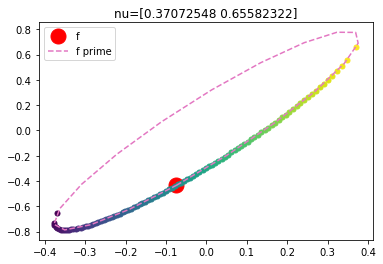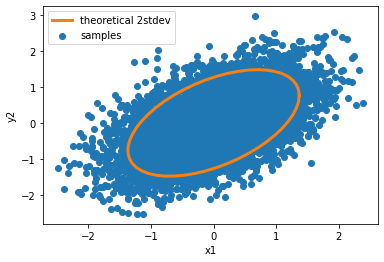Elliptical slice sampling
A Python implementation of the elegant algorithm introduced by Iain Murray et al. (2010).
The goal is to sample from a posterior distribution over latent parameters that is proportional to some likelihood times a multivariate gaussian prior that ties the latents to the observed data.
Given a vector \({\bf f} \sim \mathcal{N}(0, \Sigma)\) of latent variables and a likelihood \(L({\bf f}) = p(\text{data}\vert {\bf f})\), we want to sample the target distribution \(p^{\star}({\bf f})=\frac{1}{Z} \mathcal{N}({\bf f} ; 0, \Sigma) L({\bf f})\) where \(Z\).
Metropolis-Hastings sampling
With Metropolis-Hastings sampling, given a starting point \(\mathbf{f}\), we choose our next sample, \({\bf f}^\prime = \sqrt{1-\epsilon^2}{\bf f} + \epsilon{\bf \nu}\), where \(\nu \sim \mathcal{N(0,\Sigma)}\) and \(\epsilon \in [-1, 1]\) is a step-size parameter. The move from \({\bf f} \rightarrow {\bf f}^\prime\) is accepted with probability \(p = \min(1,L({\bf f}^\prime)/L({\bf f}))\).
The issue with MH is that \(\epsilon\) must be tuned, usually via preliminary runs of the sampler. We can visualize at how our choice of \(\epsilon\) affects \({\bf f}^\prime\).
For a fixed \(\nu\), when we vary the step size \(\epsilon\) between -1 and 1, the possible \({\bf f}^\prime\)s sweep out a portion of an ellipse (coloured points below). The trick with Elliptical Slice Sampling is that we can instead directly parameterize these possible steps by an ellipse \({\bf f}^\prime = {\bf \nu}\sin\theta + {\bf f}\cos\theta\) (pink dashed line below); this ellipse contains \({\bf f}\) (red dot). This equation is no longer dependent on \(\epsilon\)!
import numpy as np
import matplotlib.pyplot as plt
from matplotlib import cm
np.random.seed(42069)
theta = np.linspace(0, 2*np.pi, 20)
f = np.random.randn(2) # arbitrary f
nu = np.random.randn(2) # arbitrary nu
n_pts = 100
viridis = cm.get_cmap('viridis', n_pts)
# starting point f
plt.plot(f[0], f[1], 'ro', markersize=15, label='f')
# vary epsilon from [-1, 1]
for i, e in enumerate(np.linspace(-1, 1, n_pts)):
f_prime = e*nu + np.sqrt(1-e**2)*f
plt.plot(f_prime[0], f_prime[1], 'o', color=viridis(i), markersize=5, label=None)
# plot ellipse
f_prime = nu*np.sin(theta)[:, None] + f*np.cos(theta)[:, None]
plt.plot(f_prime[:,0], f_prime[:,1], 'C6--', label="f prime")
plt.title(f"nu={nu}")
plt.legend();

So for a given \({\bf f}\), \({\bf \nu}\) parameterizes the entire ellipse. Choosing an \(\epsilon\) (coloured dots) is equivalent to choosing an angle \(\theta\) on the pink ellipse. Vanilla slice sampling is a method by which to adaptively sample from a distribution, but naively using slice sampling rules on \(\theta\) does not result in a valid Markov chain transition operator (it ends up not being reversible). Elliptical slice sampling defines a valid Markov chain transition operator with which to perform adaptive sampling using ellipse states.
Implementing the elliptical slice sampler
The intuition here is that we can directly sample on the ellipse rather than worry about choosing a step size \(\epsilon\). We’re going to write an algorithm to sample a random \({\bf \nu}\), choose a point lying on a portion (bracket) of the ellipse defined by \(\nu\), then accept/reject according to a random loglikelihood threshold. If we reject, then we adjust the size of the bracket and sample again, and repeat until we accept. Note, now we no longer have to tune a step size parameter, and each iteration ultimately ends with an accepted sample.
The below class implements the algorithm defined in Figure 2 of the paper.
The main algorithm is encapsulated in the internal method _indiv_sample() in the class.
The sample() method calls _indiv_sample() n_samples times, and throws out the first n_burn samples.
from typing import Callable
from scipy.stats import multivariate_normal
class EllipticalSliceSampler:
def __init__(self, prior_mean: np.ndarray,
prior_cov: np.ndarray,
loglik: Callable):
self.prior_mean = prior_mean
self.prior_cov = prior_cov
self.loglik = loglik
self._n = len(prior_mean) # dimensionality
self._chol = np.linalg.cholesky(prior_cov) # cache cholesky
# init state; cache prev states
self._state_f = self._chol @ np.random.randn(self._n) + prior_mean
def _indiv_sample(self):
"""main algo for indiv samples"""
f = self._state_f # previous cached state
nu = self._chol @ np.random.randn(self._n) # choose ellipse using prior
log_y = self.loglik(f) + np.log(np.random.uniform()) # ll threshold
theta = np.random.uniform(0., 2*np.pi) # initial proposal
theta_min, theta_max = theta-2*np.pi, theta # define bracket
# main loop: accept sample on bracket, else shrink bracket and try again
while True:
assert theta != 0
f_prime = (f - self.prior_mean)*np.cos(theta) + nu*np.sin(theta)
f_prime += self.prior_mean
if self.loglik(f_prime) > log_y: # accept
self._state_f = f_prime
return
else: # shrink bracket and try new point
if theta < 0:
theta_min = theta
else:
theta_max = theta
theta = np.random.uniform(theta_min, theta_max)
def sample(self,
n_samples: int,
n_burn: int = 500) -> np.ndarray:
"""Returns n_samples samples"""
samples = []
for i in range(n_samples):
self._indiv_sample()
if i > n_burn:
samples.append(self._state_f.copy())
return np.stack(samples)
Let’s define some arbitrary prior and Gaussian log likelihood from which to sample.
mu_prior = np.array([0., 0.])
sigma_prior = np.array([[2, -.5],
[-.5, 1]])
mu_lik = np.array([0, 0.])
sigma_lik = np.array([[4, 5.],
[5, 7]])
def loglik(f):
"""Gaussian log likelihood"""
return np.log(multivariate_normal.pdf(f, mean=mu_lik, cov=sigma_lik))
# run our sampler!
sampler = EllipticalSliceSampler(mu_prior, sigma_prior, loglik)
samples = sampler.sample(10000, 500)
Plot the samples
Now we can plot our samples, as well as the theoretical posterior. Since I chose the convenient case where the liklihood and prior are both Gaussian, the posterior can be solved in closed form. The mean is still zero since both likelihood and prior mean are zero, but the posterior covariance is \(\Sigma_{post} = \Sigma_{prior}(\Sigma_{prior} + \Sigma_{lik})^{-1}\Sigma_{lik}.\)
With this posterior covariance, we can create a theoretical 2 stdev ellipse and see how well our samples match it.
# compute posterior covariance and correlate a circle of points to match the distribution
sigma_post = sigma_prior@np.linalg.inv(sigma_prior + sigma_lik)@sigma_lik
chol_post = np.linalg.cholesky(sigma_post)
th = np.linspace(0, 2*np.pi, 50)
pts = np.array([np.cos(th),
np.sin(th)])
rot = 2 * chol_post @ pts # 2 stdev ellipse
# plot it
plt.scatter(samples[:,0], samples[:,1], label='samples')
plt.plot(rot[0,:], rot[1,:], 'C1', linewidth=3, label='theoretical 2stdev')
plt.gca().set(xlabel='x1', ylabel='y2')
plt.legend();
print("Sample cov:\n", np.cov(samples.T))
print("Theoretical cov:\n", sigma_post)
Sample cov:
[[0.47370139 0.2620345 ]
[0.2620345 0.55132647]]
Theoretical cov:
[[0.46846847 0.26126126]
[0.26126126 0.54954955]]

Not bad! This was pretty straightforward to implement. The upside is that regardless of dimensionality of the posterior, the parameter space will always lie on a 2D plane. The downside is that this sampler is only valid when the prior is Gaussian.





